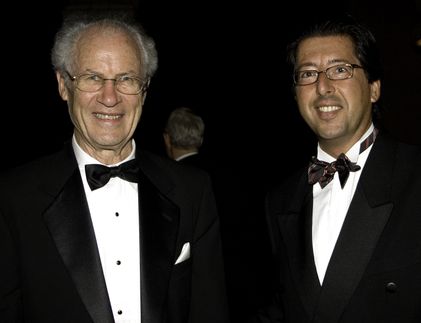QuickNanocontainer Construction
Finished in one step: nanoscale octahedral nanocontainers
Advertisement
Nanoscale containers are in high demand because of their ability to enclose molecules. They can, for example, be used asmolecular reaction chambers for controlled chemical reactions or as transporters and storage containers for drugs or pesticides; they can also filter poisonous substances out of water. The synthesis of such capsules is not easy. American researchers at Rutgers University in New Jersey have now produced an octahedral nanocontainer whose 18 components can be assembled in a single, elegant reaction step.
The chemical linking of individual components into a molecular container big enough to hold multiple or large guest molecules is usually an extremely fiddly undertaking, involving many complicated reaction steps. Therefore, a different alternative has been used until now: individual components with the ability to organize themselves into a supermolecular structure by a self-assembly process. In this process the components are not held together by solid chemical (covalent)bonds; instead, they are an aggregate of individual molecules. A team headed by Ralf Warmuth has now found a way to assemble the individual components into a single, giant, container-shaped molecule just as smoothly and spontaneously.
For their synthesis, the researchers used two different 'building blocks', six large, bowl-shaped molecules and twelve small molecules to act as bridging elements. Each bowl has four groups of atoms that particularly like to form links with the reactive amino groups at the ends of the bridges. The two substances need only be dissolved and mixed together in the right proportions to react, to form octahedral capsule-like macromolecules. The success of this small miracle depends on the flawless formation of an astounding 24 new imine bonds. How does this work? There are two secrets: The octahedral arrangement is the most energetically favorable of the possible forms, and the formation of the bonds is reversible, meaning that the freshly formed imine bonds can easily come apart again under the reaction conditions used. The components thus have the opportunity to arrange themselves into the preferred configuration little by little.
Original publication: R. Warmuth et al.; "One-Pot, 18-Component Synthesis of an Octahedral NanocontainerMolecule"; Angewandte Chemie International Edition 2005.
Other news from the department science
Most read news
More news from our other portals
See the theme worlds for related content
Topic world Synthesis
Chemical synthesis is at the heart of modern chemistry and enables the targeted production of molecules with specific properties. By combining starting materials in defined reaction conditions, chemists can create a wide range of compounds, from simple molecules to complex active ingredients.

Topic world Synthesis
Chemical synthesis is at the heart of modern chemistry and enables the targeted production of molecules with specific properties. By combining starting materials in defined reaction conditions, chemists can create a wide range of compounds, from simple molecules to complex active ingredients.
























































